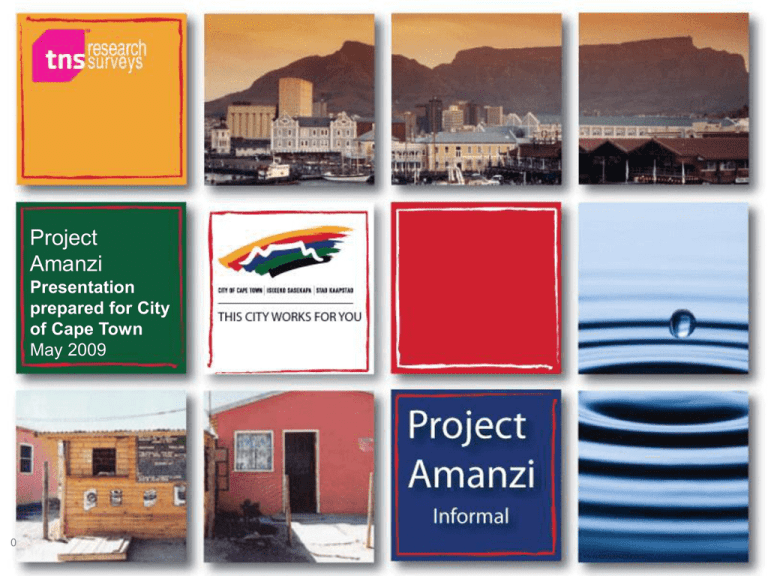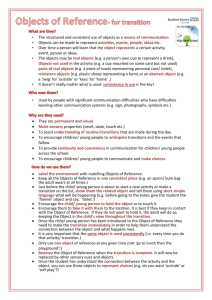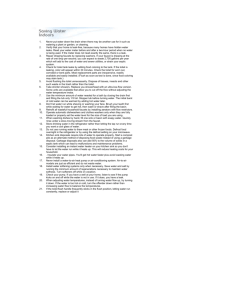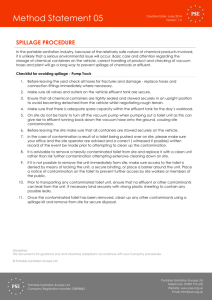Project Amanzi Presentation prepared for City
advertisement

Project Amanzi Presentation prepared for City of Cape Town May 2009 0 Introduction and Background Respondent profile Findings Summary 1 The City of Cape Town …manages the local governance of Cape Town and therefore has the important responsibility of delivery basic services. The City fulfils its mandate for the provision of basic water supply and sanitation services to business and residents of Cape Town via the Department of Water and Sanitation, Vision of the Department of Water and Sanitation: Become a leader in the provision of equitable, sustainable, people-centred, affordable and credible water services for all. Realising these objectives rests upon: 1 2 Identifying and confirming residents’ and businesses’ needs Measuring and improving satisfaction levels The research need is therefore to: Evaluate the current level of service provided 2 Understand the future needs of residents and businesses Identify key areas for improvement The research need Resident research Informal resident survey Business survey Sample size: 450 Sample size: 150 Sample size: 50 Residents of formal residential areas Residents of informal residential areas Businesses registered on RSC Levy database (2004) Face-to-face interviews Face-to-face interviews 10 March – 1 April 2009 10 March – 1 April 2009 CATI (Computer Assisted Telephonic interviews) Formal resident survey 3 Business research 9 – 20 March 2009 Project design What? Why? How? Perception and satisfaction survey Evaluate the current level of service provided by the Dept of Water and Sanitation; understand the future needs of residents; inform the development planning agenda for the City of Cape Town Quantitative research design Face-to-face in=home interviews 30-minute questionnaire in English or Xhosa Whom? Residents of the City of Cape Town aged 18+ Respondents identified through a random sampling rule within pre-defined, representative suburbs Respondent within each household selected through a random process (birthday rule) How many? Total sample of 150 When? In field from 10 March to 1 April 2009 Please note that due to a revised questionnaire in 2009, this data is not comparable with previous years’ data 4 Sample and methodology Essential services Which areas of service delivery have improved or got worse since 2007/8? Improved % 2007/8 2008/9 31 23 37 27 Service areas Deteriorated % 2007/8 2008/9 Water Sanitation 10 13 7 9 Scores (out of 5) for water and sanitation, compared with 2007/8 5 Ranked by improvement scores 2007/8 2008/9 Water provision 3.3 3.2 Giving you access to clean water 3.5 3.6 Giving you an uninterrupted water supply 3.4 3.4 Effectively managing water restrictions 3.3 3.3 Water costs being affordable 3.1 3.0 Sewerage and sanitation 3.1 3.0 Managing sewerage and sanitation 3.1 3.1 Immediately attending to sewerage and sanitation problems 3.0 2.9 Snippets from Project Robben Introduction and Background Respondent profile Findings Summary 6 Base: n=150 Age: 18-24 years 27 25-34 years 43 35-49 years 27 50-64 years 4 Race: Black 99 Coloured 1 Home Language: Xhosa 96 Sotho 2 Afrikaans 1 Relationship as a user with Water services: A resident 44 Part of the community 37 A citizen 13 Part of the people 3 A client 1 A customer 1 A consumer 1 7 D4, D3, D5, D1 61% 39% Respondent profile Base: n=150 Very well Quite well A little Not at all Level of understanding – Language 8 D2 Xhosa 93 4 1 2 English 21 49 25 5 Afrikaans 2 5 23 69 SeSotho 5 1 3 91 Setswana 0 1 1 99 Sepedi 0 1 0 99 Respondent profile Number of families? Number of buckets? Q.11f One 16 8 10 7 16 18 15 14 Two Three to four Five to six 7-8 4% 9-10 1% 11+ 2% Seven to eight 1-2 33% 5-6 19% Nine to twelve More than twelve 2 Q.13e 23 30 25 6 4 9 3 2 4 29 25 33 Total (n=97) One to three people in household (n=51) four or more people in household (n=46*) Base: n=150 9 3-4 41% Base: Respondents who have access to toilet facilities (n=97) *Caution: Small base size Average number of buckets of water used daily and Number of families with access to your toilet facilities Introduction and Background Respondent profile Findings Current water and sanitation services Communication with the City of Cape Town Satisfaction Responsible water usage behaviour Summary 10 100 100 90 90 77 80 80 70 70 60 60 50 40 41 34 40 30 30 19 20 50 20 11 10 29 6 10 0 Access to flush toilet Access to Clean, safe basic water toilet supply facilities Health & hygiene education Services provided 25 litres pp /day 0 0 Bucket type toilet Chemical toilet Waterless toilet 4 Porta-potty 1 Pit latrine Services provided Most have access to a basic water supply, but fewer than half have access to their free water allocation and education. A third have access to a flush toilet and just less than a third have access to a bucket type toilet 11 Current service delivery Base: n=127 Who maintains this service? Who provides this service? Access to basic water supply 1 25 litres of free basic water per person, per day 2 99 Access to basic water supply 98 100 Health and hygiene sanitation education 12 21 Toilet facilities that are clean and safe Access to a bucket type toilet Access to a flush type toilet 75 11 100 9 94 6 100 Access to a chemical toilet 12 88 18 6 43 4 11 50 77 23 Access to a bucket type toilet Access to a flush type toilet 95 3 2 16 67 29 6 8 100 Council or municipality Health and hygiene sanitation education Toilet facilities that are clean and safe Access to a pit/ventilated pit latrine Access to a porter potty 25 litres of free basic water per person, per day 91 10 1 17 Self or community 83 Other 100 Access to a pit/ventilated pit latrine 100 Access to a chemical toilet Access to a porter potty Council or municipality 83 17 Self or community Other None/ Other Services are perceived to have been provided and maintained by the council or municipality; clean and safe toilet facilities are mostly maintained by residents or the community Q.12h,12i Provision and maintenance of service Base: n=127 Where do the funds for maintenance come from? Where do the funds for the facilities come from? 91 5 4 Access to basic water supply 1 25 litres of free basic water per person, per day 2 Access to basic water supply 90 2 25 litres of free basic water per person, per day 6 Health and hygiene sanitation education 88 18 43 Toilet facilities that are clean and safe Toilet facilities that are clean and safe 11 Access to a bucket type toilet 6 43 4 4 4 57 67 9 Access to a bucket type toilet 23 Access to a flush type toilet 65 29 74 5 92 6 2 3 Health and hygiene sanitation education 54 88 10 1 3 28 75 18 Access to a flush type toilet 2 8 31 8 65 100 100 Access to a pit/ventilated pit latrine Access to a pit/ventilated pit latrine 89 100 Access to a chemical toilet Access to a chemical toilet 11 Access to a porter potty Council or municipality 13 83 17 Self or community Access to a porter potty Other None/ Other Council or municipality 83 17 Self or community Other None/ Other Funding for facilities and maintenance are perceived to be provided by the council or municipality; clean and safe toilet facilities are considered funded by residents or the community Q.12j, 12k Funding Base: n=150 None Standpipe 49 89 Bottled water Bottled water 43 44 Standpipe Other 7 Other Sources of drinking water 14 Q.13a, 13b 5 2 Water source respondents pay for Source of water and if paid for Base: n=150 Base: Respondents who have been stopped from getting free basic water and sanitation (n=56) Ever prevented from accessing free basic water and sanitation Yes 37% There was no water 41 It was dirty 29 It is dangerous 29 There was an unpleasant smell 25 There are none in the area 20 It was unhygienic No 63% The toilets are not working Other Q.13c, 13d 16 It was damaged or broken Cannot afford to use Cannot access the basic water and sanitation services The communal toilet was blocked 15 18 11 9 7 2 16 Stopped from accessing free basic water and sanitation and reasons Base: n=150 A leaking 4 5 standpipe 29 17 A w ater leak in the 3 7 area 27 21 Q.2c 9 15 7 3 9 42 Street committee and the council office are most frequently contacted when experiencing problems with water leaks, toilets systems and sewers There is little difference between who to contact for different types of problems A broken/blocked toilet system 5 A blocked sew er in the area 3 3 5 22 23 Plumber Street committee Local councillor friend or family member or fix it myself 16 13 13 19 9 10 8 3 3 7 3 2 Community w orker Council office Local community forum Other Contact when experiencing problems with water leakages, toilet systems or sewers Introduction and Background Respondent profile Findings Current water and sanitation services Communication with the City of Cape Town Satisfaction Responsible water usage behaviour Summary 17 Base: Respondents who have had contact with the municipality (n=52) Local community forum 18 Q.4c 38 Community workers 25 Local councillor 25 Called the City’s Call Centre 6 Other 6 Informal dwellers make use of more localised points of contact to correspond with the municipality Most used point of contact for the municipality regarding water or sanitation services To ask or complain about the waste water overflow 3 7 3 87 To ask or complain about the smell from waste water 3 7 4 86 To ask or complain about quality of water To report a burst water pipe To report a water leak at a standpipe 1 5 6 3 4 5 5 5 9 85 7 79 5 3 78 77 To report a blocked sewer in the street 2 6 8 7 To report a water leak in the street 7 9 10 In the past month 3 The reason most informal residents would have contacted the municipality in the past year is water leaks in the street 71 In the past 6 months In the past year Longer than a year ago Base: Respondents who have had contact with the municipality (n=52) Ease of contacting the municipality Very difficult 19 Q.4b, 4d 15 Fairly difficult 10 19 Fairly easy 17 Very easy Never The majority of respondents who had contact with the municipality found it neither easy nor difficult in contacting the municipality Last dealt with the municipality Base: Respondents who have had contact with the municipality (n=52) Improvement areas 100% 19 21 80% 19 21 44% 52% 23 52% 63% 33 60% 31 Following up to find out if a problem has been sorted out is an area that City of Cape Town could improve on which almost half the respondents disagreed that the municipality did Resolving problems in a ‘reasonable’ time is another area for improvement 44 40% 33 48% 33 20% 25 21 41% 15 33% 29% 8 8 You were immediately directed to the person who best see to your needs You were treated in a professional and polite manner 8 0% They followed up with to The problem was find out if the problem resolved in a reasonable had been sorted out time Disagree completely 20 Q.4b Disagree Agree Completely agree Contact with municipality in relation to water or sanitation services Base: n=150 yes 20% don't know 42% The majority of respondents are unaware of the community being consulted on decisions about water and sanitation services in their area no 38% 21 Q.4e Community consulted on decisions about basic water and sanitation services in area Base: Respondents who say that their community was consulted (n=30*) Public meetings 87 Community workers 22 *small base size Q.4f 20 Posters in council offices 17 Road shows 17 Door-todoor visits Public meetings are the primary communication platform used to keep the community conversant and involved 13 Method used to involve community and provide information Introduction and Background Respondent profile Findings Current water and sanitation services Communication with the City of Cape Town Satisfaction Responsible water usage behaviour Summary 23 Base: n=150 61% of respondents are dissatisfied with the provision of basic water and sanitation services Overall Those with continuous access to a flush toilet 35 26 7 12 Dissatisfied Very dissatisfied Very satisfied Satisfied (TOTAL) 24 Q.1a, 1a, filter Q12e 10 15 22 Only a quarter of respondents are satisfied with the provision of services 25% 37 59% Respondents who had continuous access to a flush toilet were more likely to rate the City of Cape Town basic water and sanitation services better Somewhat satisfied Satisfaction with provision of basic water and sanitation services Available, accessible and in working order MAINTENANCE GAP: gap between what’s always available and what’s actually working ACCESS GAP: gap between what is available and what is continuously accessible EXPECTATION GAP: gap between what they expect and what they have 100 90 80 70 60 50 40 30 20 10 0 Access to Access to Clean, safe Health & 25 litres pp flush toilet basic water toilet hygiene /day supply facilities education The big gap is between what residents expect and what they are getting, not in access or maintenance 25 100 90 80 70 60 50 40 30 20 10 0 Bucket type toilet Chemical toilet Waterless toilet Portapotty Pit latrine Residents do not feel that these options are their rights Service delivery gaps Base: n=150 40 Access to basic water supply 28 Access to a flush type toilet 13 25 litres of free basic water per person, per day 10 Toilet facilities that are clean and safe The most preferred services are access to basic water supply followed by access to a flush type toilet 7 Health and hygiene sanitation education Access to a bucket type toilet 2 Access to a chemical toilet 1 Access to a waterless toilet 0 Access to a pit/ventilated pit latrine 0 Access to a porter potty 0 Read: 40% of all informal residents mentioned a basic water supply as either their first, second or third most preferred service 26 Q.12g Preferred services Extremely important 5 4.5 Provides your household with Extends water aand reliable sustainable and Ensures supply sanitation supply the ofof taste of of the water is Provides polite,Provides effective Ensures that quality water 6000 freeof litres ofthe water ProvidesRestores theEnsures regular service clearing environmentally Encourages within 6tohours friendly publicper to use water services forpeople water future allthe generations people satisfactory Ensures that obey efficient communication meets to the national drinking water month Ensures Ensures Encourages that adequate water the business municipality services waterto are use sewersafter to prevent anlegislation unplanned waste blockages water interruption systems water wisely about thestandards use or community pressure uses during affordable water water peak wisely wisely supply Minimises the loss of water misuse of water Encourages people to pay for the water and sanitation services that they use 4.0 Importance 3.5 3 City of Cape Town Water and Sanitation Department is for the most part performing above the average and meeting demands, however there is room for improvement 2.5 2 All aspects may be considered priority areas 1.5 Not at all important 1 1 Poor 1.5 2 3 3.5 2.5 4 4.5 5 Excellent Rating of City of Cape Town 27 Importance and performance Ave. score Base: n=150 2.5 3.0 Ensures smell of water is satisfactory 7 32 26 Ensures colour of water is satisfactory 7 29 33 Ensures texture of water is satisfactory 8 31 Ensures taste of water is satisfactory 7 34 Ensures water quality meets national standards 9 42 28 21 2.6 Provides a sustainable supply of water 7 45 27 21 2.5 Provides a reliable supply of water 5 47 28 20 2.5 35 30 31 8 46 22 Ensures adequate water pressure 8 43 29 Ensures environmentally friendly systems 20 45 12 50 Minimises the loss of water 8 51 Restores service within 6 hours 9 50 Provides regular cleaning of sewers 17 Not applicable/Don't know 28 Q.5b Average excludes none/don’t know 31 3.0 19 16 21 14 17 2.5 2.3 Below average 2.3 17 27 Above average 2.5 19 25 Good 2.9 24 17 57 Poor/fair 3.0 28 Extends services to all Provides regular cleaning of communal toilets 31 10 2.3 2.2 2.0 very good/excellent Rating of City of Cape Town regarding infrastructural elements Ave. score Base: n=150 2.5 Provides 6000 litres free water 16 Ensures affordable water services 17 Encourages public to use water wisely Polite, effective communication 24 27 43 21 3.0 19 3.0 2.6 23 Above average 33 18 13 Encourages people to pay for used services Ensures people obey water laws 25 40 7 Encourages business to use water wisely Ensures municipality uses water wisely 38 29 26 41 23 10 8 35 45 28 56 Not applicable/Don't know 29 Q.5b Average excludes none/don’t know 25 25 Poor/fair Good 21 2.6 20 2.5 17 2.5 17 2.4 11 Below average 2.1 very good/excellent Rating of City of Cape Town regarding customer elements Introduction and Background Respondent profile Findings Current water and sanitation services Communication with the City of Cape Town Satisfaction Responsible water usage behaviour Summary 30 How would you personally get involved? Base: n=104 (those who perceive benefit in community involvement) Base: n=150 Importance of regulation of water services 83 7 10 By getting involved with a local committee that brings all the concerns that your area has with services and raises it directly with the water department 76 By providing information to the relevant complaints desk when there are water interruptions or leaks Benefit if community members got involved in monitoring service delivery of the Municipality 69 yes 31 Q.14a, 14b, 14c no 7 24 don't know 33 By raising your individual concerns with a councillor Other 30 3 Perceptions of regulation of water services Base: n=150 45% of respondents disagree with paying for water over and above the free allocation 100% 9 9 12 12 19 80% 36 45% 64% 64% 60% 67% 55 52 86% 55 67 40% 33 45% 20% 20 27% 23% 10 12 0% 19 The vast majority of informal residents believe it is one’s duty to report water leaks and overflowing sewers 3 2 12% 5 2 7% 8 Most people obey We should pay for Waste water It is our duty to Most people are water restrictions water we use often pollutes our report water aware of when they are over and above rivers leaks in the street conserving water introduced the free or pavement and allocation overflowing sewers Disagree completely 32 Q.7 Disagree Agree Completely agree Responsible water use Base: Respondents who have taken part in water conservation initiatives (n=19**) Base: n=150 don't know 7% yes 13% National Water Week 47 Hlonipha Amanzi Programme 32 Water Bylaw Awareness Programme no 80% 33 **extremely small base size Q.10a, Q10b 21 Other 11 Don't know or can't remember 11 Taken part in water conservation initiatives n=54 Base: n=150 Main reason for changing behaviour to conserve water yes 36% no 64% Information provided on water conservation Improved services in the area Other 34 Q.11a.11b 74 22 4 Changing behaviour to conserve water and reasons It is not permitted to water gardens or lawns between the hours of 10h00 and 16h00 Q.9 There is relatively low awareness of the City of Cape Town’s bylaws especially compared to formal residents It is illegal to let water from dishes or clothes or baths or showers into the storm water system It is illegal to let rain water into the sewer system None 35 Base: n=150 53 38 21 37 Awareness of bylaws Introduction and Background Respondent profile Findings Summary 36 Informal consumers are far more dissatisfied relative to business and residential consumers. 61% express some degree of dissatisfaction with the provision of basic water and sanitation services. Informal residents that have access to a flush toilet were more likely to be satisfied Although the City of Cape Town is performing well, there is still room for improvement; all service areas emerged as priority areas Quality of water, access to free water and affordability were rated best while areas of concern for the City of Cape Town are maintaining hygiene standards of facilities like communal toilets and regularly cleaning sewers, environmentally friendly systems, minimizing losses, restoring service within 6 hours and effective communication Informal residents primarily have access to water and sanitation services through the provision and maintenance of the council or municipality. In a non-structural element like the cleaning and maintaining of toilet facilities, community is more active The greatest gaps between provision and expectations are for flush toilets, clean and safe toilets and education 89% of informal dwellers get drinking water from a standpipe 5% of residents claim to be paying for standpipe water – investigation into this should be implemented Respondents who have been prevented from accessing free basic water and sanitation cite three main barriers: no water available, 37 hygiene and safety Summary Localised points of contact with the municipality are used primarily by informal dwellers; the most common point of call when experiencing problems is the street committee followed by the local council. The local community forum is the main point of contact with the municipality For the most part there has been very little interaction with the municipality over the past year When informal residents did contact the municipality, it was most likely to report a water leak in the street, blocked sewer, water leak at a standpipe or burst pipe Almost half of those who had contact with the municipality felt that follow up and resolution time could be improved The vast majority of respondents believe that the regulation of water services is important and that it would be of benefit if community members got involved in monitoring service delivery of the Municipality Informal dwellers see the provision of water services as a constitutional right, 45% of respondents also disagree with paying for water over and above the free allocation Information on water conservation is a salient reason for changing water behaviour. There is, however, relatively low awareness of the city’s bylaws related to water usage 38 Summary Thank You 39




